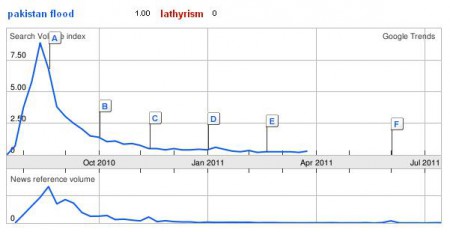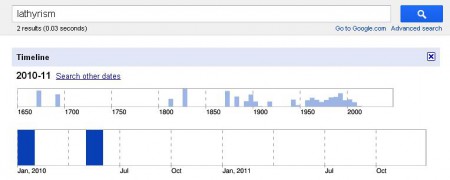- Money for AnGR conservation up for grabs.
- 8th International Food Data Conference: Biodiversity and Sustainable Diets is taking place September 14-17, 2011 at NBI Conference Centre, Norwich, UK.
- So how are we doing with that MDG1?
- More on CABI’s Plantwise. I just hope most of it will be free. They have a blog, natch.
- CIMMYT drought-tolerant maize varieties featured in blog post. I’ll alert the media. No, wait. Seems like only 60% of farmers in Kenya are willing to pay for these varieties anyway.
- No extension workers? No problem.
- A tasty dish of Ugandan grasshoppers. Always a good subject for a subtly xenophobic CNN phtoto feature.
- Cows not so bad after all?
Nibbles: Beetles, Assisted migration, Potato breeding, Chaffey, Malnutrition
- Beetles good for weeds. No news on effect of Rolling Stones on pests.
- When to move species. Acacias, for example?
- A gene to prevent inbreeding depression in potato. I’m kinda down myself today.
- As you were, Plant Cuttings has made me feel a whole lot better.
- Documenting Peru’s success in fighting malnutrition. Did fortification play a role? Hard to say from this, which focuses on policy, and in particular conditional cash transfers.
Brainfood: Chinese landscapes, Agroforestry seed, Italian lentils, Carrot heterosis, Taro in islands, Indian wheat, AnGR ex situ, Woodland shrines, Vitamin A, Caraway, Adansonia, Neotropical blueberries, Yeast genetics, Rotations
- Agricultural landscapes and biodiversity in China. Traditional farming practices good for biodiversity, modern bad. Therefore need intensification, to take pressure off natural habitats. But no, wait, that usually means monocultures and chemicals, which are bad. Oh crap. No mention of genebanks.
- Innovation in input supply systems in smallholder agroforestry: seed sources, supply chains and support systems. Decentralized commercial system probably best for getting quality agroforestry seed to smallholders. Unfortunately, nobody listening.
- Characterization of Italian lentil (Lens culinaris Medik.) germplasm by agronomic traits, biochemical and molecular markers. I object in principle to any paper that says a particular landrace is “the best.”
- The relationship between heterosis and genetic distances based on RAPD and AFLP markers in carrot. It is positive. Was this really not known before in carrots? What am I missing?
- Genetic diversity of taro (Colocasia esculenta (L.) Schott) in Vanuatu (Oceania): an appraisal of the distribution of allelic diversity (DAD) with SSR markers. 10 villages, 344 landraces, 324 distinct multilocus genotypes, genetic pattern reflects social networks. Situation in Andaman Islands not quite so interesting.
- A study of genetic diversity among Indian bread wheat (Triticum aestivum L.) cultivars released during last 100 years. More diversity after Green Revolution than before, but steadily decreasing.
- Ex situ conservation genetics: a review of molecular studies on the genetic consequences of captive breeding programmes for endangered animal species. Restricted access, and you know what? I couldn’t care less.
- Consequences of wooded shrine rituals on vegetation conservation in West Africa: a case study from the Bwaba cultural area (West Burkina Faso). I expect there are some, but with restricted access, what’s the point of even linking?
- Evaluating sweet potato as an intervention food to prevent Vitamin A deficiency. To have an effect, you’d have to replace all the other types with orange-fleshed ones. Well, almost. Wonder whether it will be presented at the “International Scientific Symposium on Food & Nutrition Security Information: From valid measurement to effective decision-making” early next year.
- Evaluation of variability of morphological traits of selected caraway (Carum carvi L.) genotypes. They’re actually breeding this stuff in Poland. But they had to get their germplasm from botanical gardens around Europe.
- Variation in baobab seedling morphology and its implications for selecting superior planting material. There is some.
- Edible Neotropical blueberries: antioxidant and compositional fingerprint analysis. The 5 species involved have different ones.
- Population genomics and speciation in yeasts. There’s a question as to whether yeast species in fact exist in any meaningful sense.
- Cereal–forage rotations effect on biochemical characteristics of topsoil and productivity of the crops in Mediterranean environment. Continuous cereal stressed the soil.
Bringing back local foods in Bolivia
http://www.youtube.com/watch?v=Y6Z7CcFa6_cIn El Alto, Bolivia, Heifer International supported a series of workshops at eight local schools about healthy food made with traditional, local ingredients. The families who attended these workshops then conducted similar workshops in other schools, and later organized a street fair to raise awareness of the importance of local foods.
If you share money, you have half of the money; if you share bread, you have half of the bread; if you share knowledge, you have twice as much!
Flooding and lathyrism
28 July 2011 marks the first anniversary of the 2010 floods in Pakistan — one of the world’s most devastating natural disasters in recent times. Nearly a fifth of the country was flooded, affecting over 20 million people and resulting in some 14 million people in need of humanitarian aid. Livestock was killed, crops were destroyed, and infrastructure and other livelihood assets were damaged on an unprecedented scale.
Dirk Enneking posted a link to the article from the UN Office for the Coordination of Humanitarian Affairs from which this quote is taken on his Facebook page earlier today, with this comment:
…let’s hope that grasspea consumption is not excessive. It saves lives but for some it is at the cost of lifelong crippling. Hence its use as a food needs to be managed carefully.
I wondered why grasspea consumption might be expected to be excessive after floods, and Dirk was kind enough to explain:
…since it is cultivated there, it grows after floods when other crops don’t and some people have nothing else to eat; and it is cheaply available from across the border in India — classic situation for a lathyrism epidemic…
Interesting, I thought. So is there any evidence of a lathyrism epidemic in Pakistan in the aftermath of the flooding. Google Trends picks up the blip in searches for “Pakistan floods” in 2010, of course, but there are no subsequent blips for “lathyrism” or indeed “epidemic”.
And there’s also no evidence from Google of increased references to lathyrism in news items after the 2010 floods.
Not yet, anyway. Something to keep an eye on…

